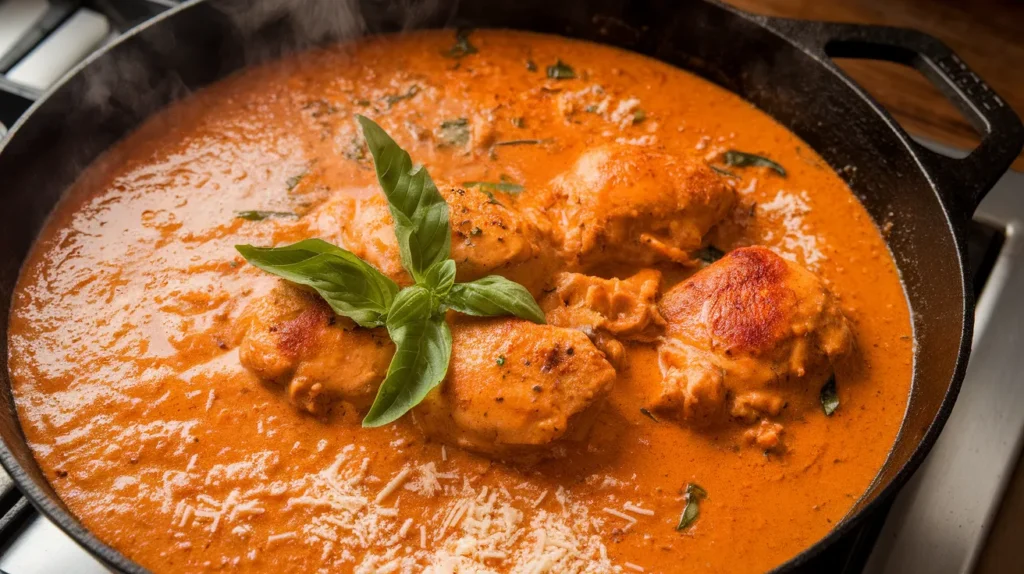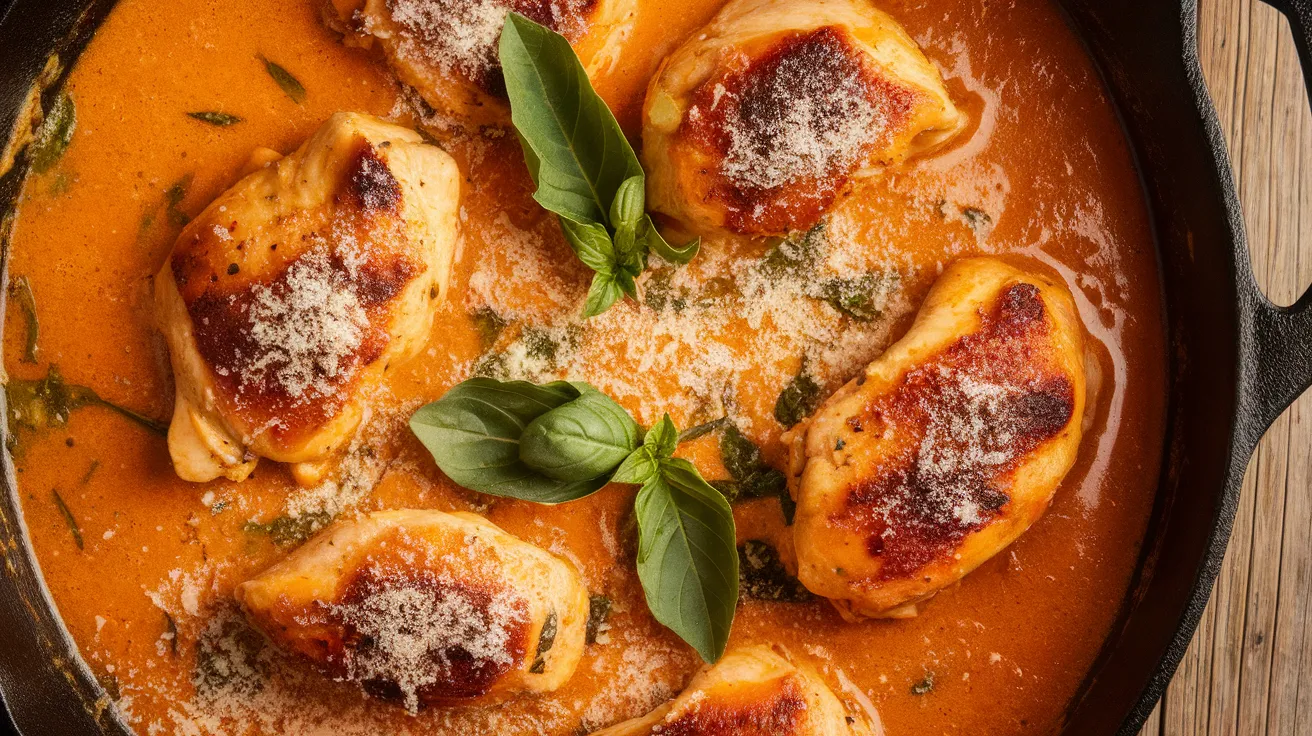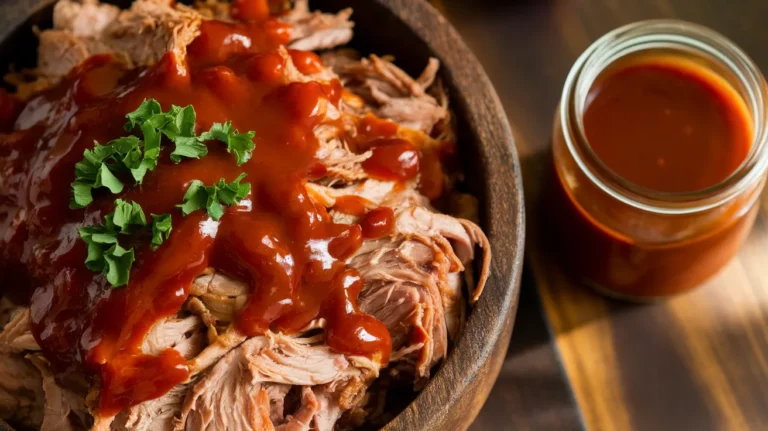This foolproof sauce for Italian chicken brings authentic Italian flavors straight to your kitchen with simple ingredients and beginner-friendly techniques. Our step-by-step sauce for Italian chicken guide ensures perfect results every time, creating a rich, creamy coating that transforms ordinary chicken into an extraordinary meal your whole family will love.
SERVES: 4 | PREP: 15 MIN | COOK: 25 MIN | TOTAL: 40 MIN
Ingredients
For the Sauce Base
| Ingredient | Amount |
|---|---|
| Olive oil | 3 tablespoons |
| Yellow onion, diced | 1 medium |
| Garlic cloves, minced | 4 cloves |
| Crushed tomatoes | 1 can (28 oz) |
| Tomato paste | 2 tablespoons |
Seasoning & Herbs
| Ingredient | Amount |
|---|---|
| Dried basil | 2 teaspoons |
| Dried oregano | 1 teaspoon |
| Fresh thyme | 1 tablespoon |
| Red pepper flakes | 1/4 teaspoon |
| Salt | 1 teaspoon |
| Black pepper | 1/2 teaspoon |
Finishing Touches
| Ingredient | Amount |
|---|---|
| Heavy cream | 1/2 cup |
| Fresh basil leaves | 1/4 cup, chopped |
| Parmesan cheese, grated | 1/2 cup |
| Butter | 2 tablespoons |
Step-by-Step Instructions for Homemade Italian Chicken Sauce
Phase 1: Preparing Your Workspace and Foundation (10 minutes)
Step 1: Set Up Your Kitchen Station Before you begin making your sauce for Italian chicken, gather all ingredients on your counter. This French technique called “mise en place” prevents mistakes and makes cooking smoother. Open your can of tomatoes now – you’ll need it quickly once cooking starts. Set your stove to medium heat and let your pan warm for 2-3 minutes before adding oil.
Step 2: Heat the Olive Oil Properly Pour 3 tablespoons of olive oil into your large skillet or saucepan. The pan should be warm but not smoking hot. To test if it’s ready, flick a tiny drop of water into the oil – it should sizzle gently but not violently. If the oil starts smoking, remove it from heat for 30 seconds to cool down. Proper oil temperature prevents burning and ensures even cooking.
Step 3: Cook the Onions Until Translucent Add your diced onion to the warm oil. You should hear a gentle sizzling sound immediately – this means your temperature is perfect. Stir the onions every 60-90 seconds using a wooden spoon. Cook for 4-5 minutes total until they become soft and see-through (translucent). They should not turn brown or caramelized at this stage. If they start browning too quickly, lower your heat slightly.
Step 4: Add Garlic Without Burning Push the cooked onions to one side of your pan and add the minced garlic to the empty space. This technique prevents the garlic from burning while it cooks. Stir the garlic constantly for 60 seconds – no longer! Fresh garlic cooks very quickly and turns bitter if overcooked. You’ll smell an amazing aroma when it’s ready. Now mix the garlic with the onions.
Step 5: Brown the Tomato Paste Add 2 tablespoons of tomato paste directly to your onion and garlic mixture. Using your wooden spoon, stir constantly for 2 full minutes. The tomato paste will darken slightly and become fragrant – this process is called “blooming” and it concentrates the tomato flavor. Don’t skip this step! It’s what separates restaurant-quality sauces from basic ones.
Phase 2: Building Your Italian Chicken Sauce Base (12 minutes)
Step 6: Add Tomatoes Safely Remove your pan from heat temporarily (this prevents dangerous splattering). Slowly pour in your 28 oz can of crushed tomatoes while stirring continuously. The mixture will bubble and steam – this is normal! Return the pan to medium-low heat. The temperature change will cause vigorous bubbling initially, then it will calm down.
Step 7: Season with Dried Herbs Add 2 teaspoons dried basil, 1 teaspoon dried oregano, 1 tablespoon fresh thyme, and 1/4 teaspoon red pepper flakes. Stir everything together thoroughly. Dried herbs need time and heat to release their flavors, which is why we add them now instead of at the end.
Step 8: Season with Salt and Pepper Add 1 teaspoon salt and 1/2 teaspoon black pepper. Remember, you can always add more seasoning later, but you can’t take it out! Stir well to distribute the seasoning evenly throughout your sauce for Italian chicken.
Step 9: Bring to a Proper Simmer Increase heat to medium and watch your sauce carefully. You want to see small bubbles forming around the edges and occasionally breaking the surface – this is a gentle simmer. If large bubbles are rapidly breaking the surface, your heat is too high. Adjust accordingly.
Step 10: Simmer and Reduce Once you achieve the perfect simmer, reduce heat to medium-low. Cook uncovered for 10 minutes, stirring every 3-4 minutes to prevent sticking. Use this time to scrape up any browned bits from the bottom of the pan – they add incredible flavor. Your sauce should thicken slightly and the color will deepen.
Phase 3: Creating the Creamy Finish (8 minutes)
Step 11: Prepare for Cream Addition This is the most critical step for smooth sauce for Italian chicken! Reduce your heat to the lowest possible setting. High heat will cause the cream to curdle and separate, creating an unappetizing grainy texture. Wait 30 seconds for the temperature to drop before proceeding.
Step 12: Add Cream Slowly and Carefully Remove the pan from heat completely. Slowly drizzle 1/2 cup heavy cream into your sauce while stirring constantly with a whisk or wooden spoon. Add it gradually over 60 seconds – rushing this step ruins the texture. Return to lowest heat setting and stir for another minute.
Step 13: Incorporate Butter for Silky Texture Add 2 tablespoons of butter one piece at a time. Cut your butter into small cubes first for easier melting. Stir each piece until completely melted before adding the next. This technique, called “mounting,” creates the glossy, restaurant-quality finish that makes your sauce for Italian chicken look professional.
Step 14: Add Fresh Herbs and Cheese Remove from heat and stir in 1/4 cup chopped fresh basil and 1/4 cup grated Parmesan cheese (save the remaining cheese for serving). Fresh herbs lose their bright flavor when overcooked, so we add them at the very end. The residual heat will warm them just enough.
Step 15: Final Seasoning Adjustment Taste your sauce using a clean spoon (never double-dip!). The sauce should be rich, balanced, and coat the back of your spoon. Add more salt if needed, or a pinch of sugar if it tastes too acidic. Trust your taste buds – they know what you like!
Step 16: Keep Warm for Serving If not using immediately, keep your Italian chicken sauce warm on the lowest heat setting. Stir every few minutes to prevent a skin from forming on top. If it gets too thick while waiting, thin with a splash of chicken broth or pasta water.
Chef’s Notes for Perfect Italian Chicken Sauce
Temperature Control: The biggest mistake beginners make with sauce for Italian chicken is using too high heat when adding dairy. Low and slow is your mantra for creamy perfection.
Herb Timing: Fresh herbs lose their potency quickly when cooked, so add them in the final minutes for maximum flavor impact in your sauce.
Consistency Tips: If your Italian chicken sauce becomes too thick, thin it with a splash of pasta water or chicken broth. Too thin? Simmer uncovered for a few extra minutes to reduce.
Make-Ahead Magic: This sauce for Italian chicken actually improves after sitting overnight as the flavors continue to develop and marry together beautifully.
Nutrition Information (Per Serving)
- Calories: 245
- Protein: 8g
- Carbohydrates: 14g
- Fat: 18g
- Fiber: 3g
- Sodium: 680mg
Creative Variations for Your Italian Chicken Sauce
Spicy Arrabbiata Style
Add an extra teaspoon of red pepper flakes and a diced jalapeño for heat lovers. This variation pairs beautifully with grilled chicken thighs and creates a bolder sauce for Italian chicken.
Herb Garden Blend
Replace dried herbs with 1/4 cup mixed fresh herbs like rosemary, sage, and marjoram. Similar to our sauce for chicken wings, fresh herbs create incredible depth.
Sun-Dried Tomato Twist
Fold in 1/3 cup chopped sun-dried tomatoes during the simmering phase for concentrated tomato flavor and chewy texture contrast in your Italian chicken sauce.
Wine-Enhanced Version
Deglaze the pan with 1/2 cup white wine before adding tomatoes. Let it reduce by half for sophisticated flavor notes that complement our sauce for Jamaican jerk chicken collection.
Storage & Reheating Your Sauce for Italian Chicken
Refrigerator Storage: Cool completely before transferring to airtight containers. Your Italian chicken sauce keeps fresh for up to 5 days when properly stored.
Freezing Instructions: Freeze in portion-sized containers for up to 3 months. Note that cream-based sauces may separate slightly when thawed but still taste delicious.
Reheating Method: Warm gently over low heat, whisking frequently. Add a splash of cream or broth if needed to restore smooth consistency.
Food Safety: Always reheat to 165°F internal temperature and avoid reheating more than once to maintain food safety.

Troubleshooting Guide for Italian Chicken Sauce
Problem: Sauce is Too Acidic
Solution: Add 1-2 teaspoons of sugar or honey to balance the acidity from tomatoes. This common fix works perfectly for any sauce for Italian chicken that tastes too sharp.
Problem: Cream Separated and Looks Curdled
Solution: Remove from heat immediately and whisk vigorously. If that doesn’t work, blend briefly with an immersion blender to restore smoothness.
Problem: Sauce is Too Thin
Solution: Create a slurry with 1 tablespoon cornstarch and 2 tablespoons cold water. Whisk into simmering sauce until your Italian chicken sauce thickens properly.
Problem: Garlic Burned and Tastes Bitter
Solution: Unfortunately, burned garlic cannot be salvaged and will ruin the entire sauce. Start over with the aromatics for the best results.
Problem: Not Enough Flavor
Solution: Check your salt levels first, then add more herbs. Sometimes a splash of balsamic vinegar brightens up your sauce for Italian chicken perfectly.
Equipment Essentials
- Large skillet or saucepan (at least 3-quart capacity)
- Wooden spoon for stirring without scratching
- Sharp knife for mincing garlic and chopping herbs
- Measuring cups and spoons
- Can opener for tomatoes
- Whisk for smooth cream incorporation
- Cutting board
Shopping List
Produce Section
- 1 medium yellow onion
- 1 head fresh garlic
- 1 container fresh basil
- 1 package fresh thyme
Pantry Aisle
- Olive oil
- Crushed tomatoes (28 oz can)
- Tomato paste
- Dried basil and oregano
- Red pepper flakes
- Salt and black pepper
Dairy Section
- Heavy cream
- Butter
- Parmesan cheese (block for grating)
Success Secrets for Perfect Italian Chicken Sauce
1. Room temperature ingredients blend more easily, so take cream and butter out 30 minutes before cooking your sauce for Italian chicken.
2. Always taste your sauce at multiple stages and adjust seasonings accordingly – your palate is the best guide for perfect flavor balance.
3. Use the highest quality canned tomatoes you can afford. San Marzano varieties offer superior flavor and texture that elevate any Italian chicken sauce.
4. Don’t skip the tomato paste browning step – this concentrated cooking develops deep, complex flavors you can’t achieve otherwise.
5. Keep some pasta water or chicken broth handy for consistency adjustments. The starch in pasta water helps bind your sauce for Italian chicken together beautifully.




